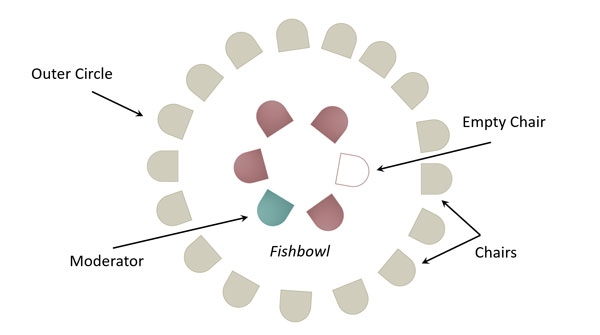“Fishbowl”

PURPOSE:
to understand that having purposeful conversations build understanding;
to use Jeroski’s “Super Seven” skills (below) to model behaviours and language that build purposeful conversations
to have students articulate what purposeful conversations look and sound like.
ACTIVITY 1: MODELLING PURPOSEFUL CONVERSATION BETWEEN ADULTS

1. A day or two before class, gather three or four teachers/adults from the building. Select a “Super Seven” skill, a question and a short text/video and ensure every adult has read it prior to coming into class. Make sure the adults understand which skill you’re going to work with.
2. The day of the “Fishbowl”, invite adults in and ask students to choose one of the adults to observe during the conversation. (Ensure all adults have several student observers.) Gather the adults in the centre of the room. The remainder of the class gathers around in a circle.
3. As the conversation unfolds, students are to record their observations (for one person only) on a T Chart. They are to record the good, the bad and the ugly:
What did you see? | What did you hear? |
e.g. Ms. X regularly made eye contact, but once she rolled her eyes; - She folded her arms once and leaned back from the table; - She leaned forward when she got excited about something.
| e.g. Lots of questions like “Why did you think that?” or “Could you explain that?” - Statements like, “I don’t agree, but I guess I see your point” or “I don’t understand what you mean.” - Connections to other people’s ideas like, “That happened to me, too” or “I thought the same thing.” |
4. At the end of the discussion, debrief with the whole class. Record students’ observations on flip chart paper. These lists serve as the beginning of criteria. You can then organize it into your own rubric, or you can use it as a springboard and refer to other frameworks and rubrics.
5. Post your criteria in the class for future reference in inquiry conversations, or for self and peer assessments.
ACTIVITY 2: PRACTISING PURPOSEFUL CONVERSATION AMONG STUDENTS
1. Select one (or more) of Sharon Jaroski’s “Super Seven” skills to target and discuss it with the class a day or so before the lesson. (Example: “contribute ideas the group can use and discuss”)
2. Choose an inquiry question, either one the class is working on or a new one for this exercise, along with a short text, video etc. that relates to the question. Present the question to the class and have them discuss it in pairs for a few minutes.
3. Ask two or three students to join you for a conversation. Gather with them in the centre of the room. The remainder of the class gathers around you in a circle.
4. Remind students of the “Super Seven” skill you’re working with for this session. Ask students to observe the small group in the centre (the fishbowl) and record on paper what the “fish” in the centre do when they work with the skill.
5. At the end of the discussion, debrief with the whole class. Record their comments on flip chart paper and post in the class for future reference.
Example of a “Super Seven” Chart:
Goal: Contribute ideas the group can use and discuss | Goal: Respond and add to others’ ideas |
What did this look like?
What did this sound like?
| What did this look like?
What did this sound like?
|
SHARON'S SUPER SEVEN:
DEVELOPING ORAL LANGUAGE IN THE CLASSROOM
Below is Sharon’s Super Seven, a list of 7 skills students can employ in order to be more effective oral communicators in the classroom. There are 2 aspects to each skill. The first is building an oral skill or strategy. The second is using that skill or strategy to build community.
Building Oral Skills and Strategies | Creating Community |
1. Enter a conversation or discussion. | 1. Invite others into a conversation or discussion. |
2. Put forward ideas cautiously. (showing care or thoughtfulness) | 2. Show others that you have an open mind and that you are willing to consider their ideas. |
3. Disagree appropriately. | 3. Show that you are willing to listen to and respond to views different from your own. |
4. Explain your ideas with enough detail to make them clear. | 4. Restate what another has said in order to make it simpler / shorter and perhaps easier for the group to understand. |
5. Contribute ideas the group can use and discuss. | 5. Acknowledge and build on others’ ideas. |
6. Ask questions that move the discussion or activity forward. | 6. Respond to questions with relevant information and ideas. |
7. Offer solutions for problems or strategies for reaching consensus. | 7. Show that you are willing to compromise and don’t always have to be right. |